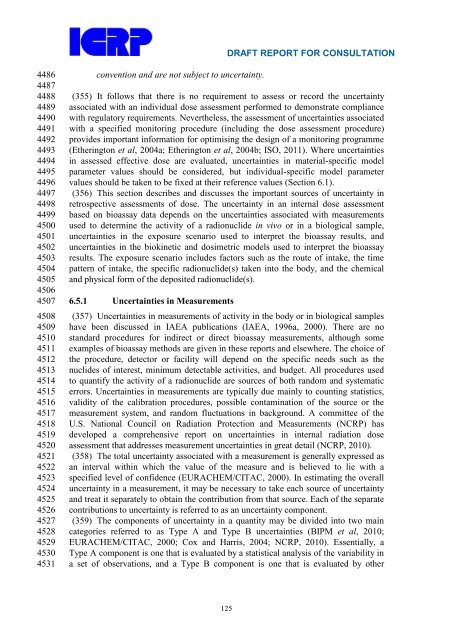Occupational Intakes of Radionuclides Part 1 - ICRP
Occupational Intakes of Radionuclides Part 1 - ICRP
Occupational Intakes of Radionuclides Part 1 - ICRP
Create successful ePaper yourself
Turn your PDF publications into a flip-book with our unique Google optimized e-Paper software.
4486<br />
4487<br />
4488<br />
4489<br />
4490<br />
4491<br />
4492<br />
4493<br />
4494<br />
4495<br />
4496<br />
4497<br />
4498<br />
4499<br />
4500<br />
4501<br />
4502<br />
4503<br />
4504<br />
4505<br />
4506<br />
4507<br />
4508<br />
4509<br />
4510<br />
4511<br />
4512<br />
4513<br />
4514<br />
4515<br />
4516<br />
4517<br />
4518<br />
4519<br />
4520<br />
4521<br />
4522<br />
4523<br />
4524<br />
4525<br />
4526<br />
4527<br />
4528<br />
4529<br />
4530<br />
4531<br />
convention and are not subject to uncertainty.<br />
DRAFT REPORT FOR CONSULTATION<br />
(355) It follows that there is no requirement to assess or record the uncertainty<br />
associated with an individual dose assessment performed to demonstrate compliance<br />
with regulatory requirements. Nevertheless, the assessment <strong>of</strong> uncertainties associated<br />
with a specified monitoring procedure (including the dose assessment procedure)<br />
provides important information for optimising the design <strong>of</strong> a monitoring programme<br />
(Etherington et al, 2004a; Etherington et al, 2004b; ISO, 2011). Where uncertainties<br />
in assessed effective dose are evaluated, uncertainties in material-specific model<br />
parameter values should be considered, but individual-specific model parameter<br />
values should be taken to be fixed at their reference values (Section 6.1).<br />
(356) This section describes and discusses the important sources <strong>of</strong> uncertainty in<br />
retrospective assessments <strong>of</strong> dose. The uncertainty in an internal dose assessment<br />
based on bioassay data depends on the uncertainties associated with measurements<br />
used to determine the activity <strong>of</strong> a radionuclide in vivo or in a biological sample,<br />
uncertainties in the exposure scenario used to interpret the bioassay results, and<br />
uncertainties in the biokinetic and dosimetric models used to interpret the bioassay<br />
results. The exposure scenario includes factors such as the route <strong>of</strong> intake, the time<br />
pattern <strong>of</strong> intake, the specific radionuclide(s) taken into the body, and the chemical<br />
and physical form <strong>of</strong> the deposited radionuclide(s).<br />
6.5.1 Uncertainties in Measurements<br />
(357) Uncertainties in measurements <strong>of</strong> activity in the body or in biological samples<br />
have been discussed in IAEA publications (IAEA, 1996a, 2000). There are no<br />
standard procedures for indirect or direct bioassay measurements, although some<br />
examples <strong>of</strong> bioassay methods are given in these reports and elsewhere. The choice <strong>of</strong><br />
the procedure, detector or facility will depend on the specific needs such as the<br />
nuclides <strong>of</strong> interest, minimum detectable activities, and budget. All procedures used<br />
to quantify the activity <strong>of</strong> a radionuclide are sources <strong>of</strong> both random and systematic<br />
errors. Uncertainties in measurements are typically due mainly to counting statistics,<br />
validity <strong>of</strong> the calibration procedures, possible contamination <strong>of</strong> the source or the<br />
measurement system, and random fluctuations in background. A committee <strong>of</strong> the<br />
U.S. National Council on Radiation Protection and Measurements (NCRP) has<br />
developed a comprehensive report on uncertainties in internal radiation dose<br />
assessment that addresses measurement uncertainties in great detail (NCRP, 2010).<br />
(358) The total uncertainty associated with a measurement is generally expressed as<br />
an interval within which the value <strong>of</strong> the measure and is believed to lie with a<br />
specified level <strong>of</strong> confidence (EURACHEM/CITAC, 2000). In estimating the overall<br />
uncertainty in a measurement, it may be necessary to take each source <strong>of</strong> uncertainty<br />
and treat it separately to obtain the contribution from that source. Each <strong>of</strong> the separate<br />
contributions to uncertainty is referred to as an uncertainty component.<br />
(359) The components <strong>of</strong> uncertainty in a quantity may be divided into two main<br />
categories referred to as Type A and Type B uncertainties (BIPM et al, 2010;<br />
EURACHEM/CITAC, 2000; Cox and Harris, 2004; NCRP, 2010). Essentially, a<br />
Type A component is one that is evaluated by a statistical analysis <strong>of</strong> the variability in<br />
a set <strong>of</strong> observations, and a Type B component is one that is evaluated by other<br />
125

















